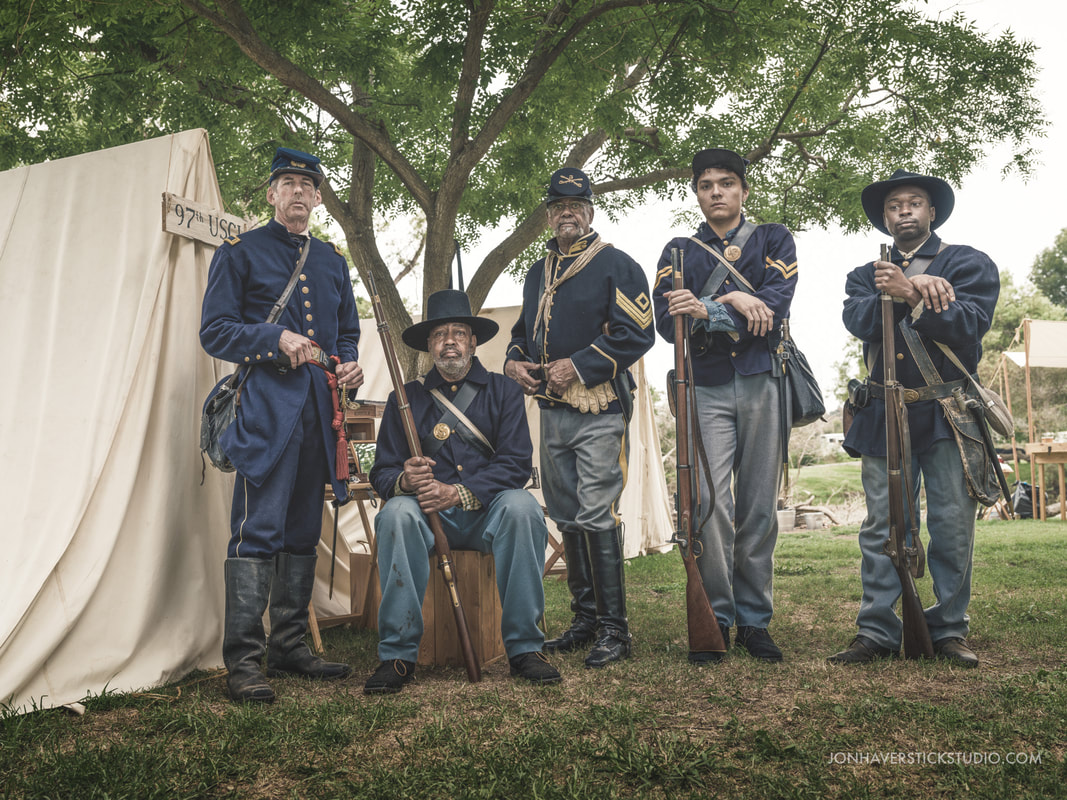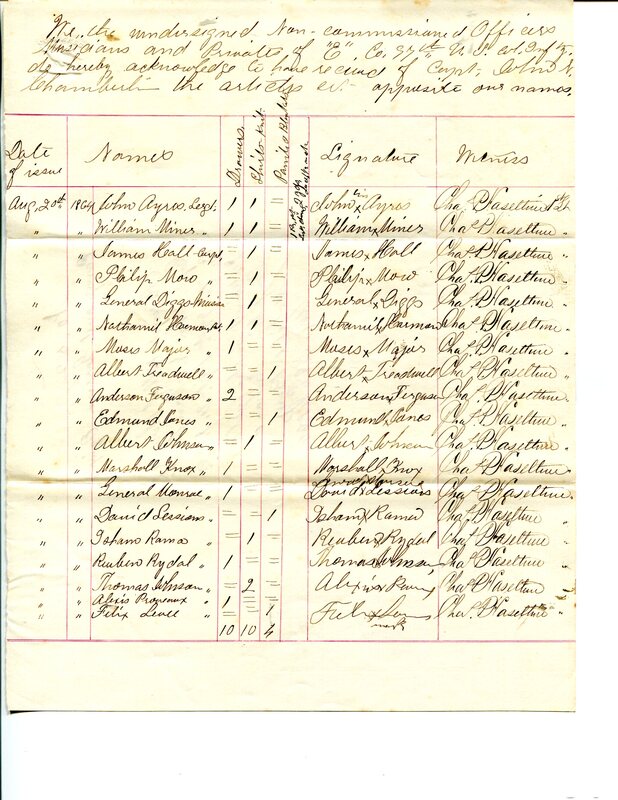Representing Louisiana U.S. Colored Regiments,
Corps d'Afrique
|
Living History Events
Our U.S. Colored Troops reenactment group participates in Civil War events throughout Southern California. We are always looking for new members to join our group. We have loaner gear for anyone getting started in the hobby. This website contains several pages devoted to portraying a U.S. Colored Troops soldier as a reenactor/living historian. Those are:
Living History Past Events Upcoming Events Uniform, Accoutrements, etc. Safety Rules Information about our next event is located in the link just below.
|
Historical Research
This site provides a historical reference for any individual doing research on U.S. Colored Troops, especially the First Louisiana Native Guards and Engineers (73rd, 95th & 97th USCTs). We have several pages on this website devoted to the First Louisiana Engineers and the USCT regiments they would become. The pull down menu/tabs at the top of this page will give access to the following pages:
73rd USCT 97th USCT 95th USCT Engineers Officers Enlisted Men Pay, Bounties, Draft, Etc. Historical Images of the Regiment Louisa Miller/Fisher Sergeant Peter Gordon, Will Smith, and Emancipation |
Be part of our living history group.
|
|
Black Americans were an important factor in destroying slavery in the United States during the American Civil War. Author Clint Smith narrates the Crash Course series "Black American History." His video titled Black Americans in the Civil War can be viewed through this link.
|
|
Anthony J. Cade II speaks about African-Americans in Louisiana under French colonial rule up to the outbreak of the American Civil War. He points out their cultural, political and economic status in Louisiana and the military contributions of Black Louisianans up to the formation of the Louisiana Native Guards (73rd USCT). A.J. Cade II then delves into the fascinating story of the Louisiana Native Guards, the first Black regiments constituted in the Union Army during the Civil War. His presentation includes the perceptions of black soldiers in the US military and reactions of the British and French as a result. He is the author of a number of articles on the subaltern of the war, all of which have shed light on immigrants and African Americans who served in the military.
|
Brief History of the "First Louisiana"
Corps d'Afrique Regiments
U.S. General Phelps had attempted to uniform and arm the men in the Camp Parapet contraband camp only after a few months after the U.S. had retaken New Orleans in the spring of 1862. His request was denied by Maj. Gen. Butler, but only a few weeks later, as the conditions rapidly changed, the free men of color who had previously been in a Louisiana Militia were authorized to form a regiment. These men became one of the first U.S. colored regiments, the 1st Louisiana Native Guards, and were mustered into service in New Orleans, Louisiana on September 27th, 1862. A good number of the men were had previously served in a militia group of the free colored population in New Orleans that had been utilized since the War of 1812. Because they were not "white" the Native Guards were never authorized or recognized by the Confederacy. After New Orleans was occupied by the United States in April 1862, Maj. Gen Butler mustered the black regiment in August of 1862 prior to official authorization from Washington. One of the first regiments of colored troops in the federal army, most of its officers were men of color when the regiment originally formed. The enlistment of so many volunteers of black men resulted in the formation of the 2nd and 3rd Louisiana Native Guards only a few months later. Most of the enlisted men in those regiments had previously been enslaved.
The African American laborers working for the Engineer Department that had been asked to be uniformed, armed and mustered in by Gen. Phelps, were eventually musted into service . These men became the 1st Louisiana Engineers and they were mustered into service on April 28, 1863 at Camp Parapet contraband camp in Carrollton, Louisiana near New Orleans. Commanded by Massachusetts abolitionist Justin Hodge, the regiment was immediately sent to the Siege of Port Hudson alongside the 1st, 3rd, and 4th Louisiana Native Guard and participated in the May and June assaults. The colored regiments of the "Black Phalanx" were praised for their heroism and work performed during the siege.
After the siege, the engineer regiment was split into two as the 1st and 3rd Regiment Engineers, Corps d'Afrique (95th and 97th USCTs). The Louisiana Native Guard regiments that also participated in the siege would later be designated as the 73rd, 75th, and 76th U.S. Colored Infantries in the closing weeks of the Red River Campaign in the spring of 1864.
The 3rd Regiment Engineers, Corps d'Afrique was commanded by Col. George D. Robinson. The 97th USCT would participate in the Red River campaign as part of the Engineer Brigade and play a significant role in bridging, building earthworks and building Bailey's Dam which saved the U.S. Navy's Mississippi River Squadron. The regiment was engaged in the Battle of Escambia Creek (Pine Barren) in the winter of 1864 and in the last major campaign of the war in the spring of 1865 ending with the sieges of Spanish Fort and Fort Blakeley, in which the 73rd USCT would also participate. After hostilities had ended, the 97th USCT would provide police duties in the city of Mobile and several officers and men served with the Freedmen's Bureau in the city. The 97th USCT mustered out in April, 1866 and had one of the longest service records of any USCT regiment.
The other half of the First Louisiana Engineers would be the officers and men of the 95th U.S.C.T.. The 95th USCT was sent to Brazos Santiago, Texas and helped rebuild Fort Brown, Brownsville, Texas. While at Brazos Santiago, a later consolidation took place in August 1864 that combined the 95th and 87th USCTs into the 81st Regiment Engineers, Corps d'Afrique (a temporary designation). The regiment would be then designated as the 87th U.S. Colored Infantry (new) on December 19, 1864. Attached to the United States Forces, Texas, Department of the Gulf, to August 1865. On August 14, 1865, a final consolidation took place into the 84th U.S. Colored Infantry. Attached to the Northern District of Louisiana, Department of the Gulf, the officers and men mustered out in March 1866.
The 1st Cavalry, Corps d'Afrique (4th U.S. Colored Cavalry) was organized at New Orleans, Louisiana, and mustered in on September 12, 1863,[2] for three years' service. The regiment was composed primarily of freedmen from other states and areas of Louisiana not under Union control and escaped slaves from the New Orleans area. The regiment underwent cavalry training at the Cavalry Camp of Instruction at Greenville, Louisiana and was then moved to Camp Parapet, just north of New Orleans. The regiment was initially assigned to the Defenses of New Orleans and stationed at various New Orleans-area bases including Camp Colfax, Camp Parapet, and Fort Butler at Donaldsonville. Their service was primarily menial labor and garrison duty at Camp Parapet. However, in October 1863, a detachment of companies A and C was detailed to Company Canal (near present-day Westwego) to protect the New Orleans & Opelousas Railroad. On April 4, 1864, the Corps d'Afrique was placed under the United States Colored Troops, and the 1st Cavalry, Corps d'Afrique was redesignated as the 4th United States Colored Cavalry.
On August 8, 1864, the 4th was relieved from duty under the Defenses of New Orleans and transferred from Camp Parapet to Port Hudson under the U.S. Forces at Port Hudson where they received their mounts and participated in several strikes into enemy territory. In April, 1865, the regiment accompanied three expeditions to provide protection for telegraph construction. After the war they were tasked with providing peacekeeping duties during the Reconstruction era, detachments of the regiment would serve at various points throughout Louisiana, including Baton Rouge, Bayou Sara, Monroe, and Vidalia until December 1865, when the regiment was ordered to Baton Rouge and then to Greenville. The regiment mustered out at Greenville on March 20, 1866.
Please utilize the menu at the top of this page to access the additional pages on this website.
The African American laborers working for the Engineer Department that had been asked to be uniformed, armed and mustered in by Gen. Phelps, were eventually musted into service . These men became the 1st Louisiana Engineers and they were mustered into service on April 28, 1863 at Camp Parapet contraband camp in Carrollton, Louisiana near New Orleans. Commanded by Massachusetts abolitionist Justin Hodge, the regiment was immediately sent to the Siege of Port Hudson alongside the 1st, 3rd, and 4th Louisiana Native Guard and participated in the May and June assaults. The colored regiments of the "Black Phalanx" were praised for their heroism and work performed during the siege.
After the siege, the engineer regiment was split into two as the 1st and 3rd Regiment Engineers, Corps d'Afrique (95th and 97th USCTs). The Louisiana Native Guard regiments that also participated in the siege would later be designated as the 73rd, 75th, and 76th U.S. Colored Infantries in the closing weeks of the Red River Campaign in the spring of 1864.
The 3rd Regiment Engineers, Corps d'Afrique was commanded by Col. George D. Robinson. The 97th USCT would participate in the Red River campaign as part of the Engineer Brigade and play a significant role in bridging, building earthworks and building Bailey's Dam which saved the U.S. Navy's Mississippi River Squadron. The regiment was engaged in the Battle of Escambia Creek (Pine Barren) in the winter of 1864 and in the last major campaign of the war in the spring of 1865 ending with the sieges of Spanish Fort and Fort Blakeley, in which the 73rd USCT would also participate. After hostilities had ended, the 97th USCT would provide police duties in the city of Mobile and several officers and men served with the Freedmen's Bureau in the city. The 97th USCT mustered out in April, 1866 and had one of the longest service records of any USCT regiment.
The other half of the First Louisiana Engineers would be the officers and men of the 95th U.S.C.T.. The 95th USCT was sent to Brazos Santiago, Texas and helped rebuild Fort Brown, Brownsville, Texas. While at Brazos Santiago, a later consolidation took place in August 1864 that combined the 95th and 87th USCTs into the 81st Regiment Engineers, Corps d'Afrique (a temporary designation). The regiment would be then designated as the 87th U.S. Colored Infantry (new) on December 19, 1864. Attached to the United States Forces, Texas, Department of the Gulf, to August 1865. On August 14, 1865, a final consolidation took place into the 84th U.S. Colored Infantry. Attached to the Northern District of Louisiana, Department of the Gulf, the officers and men mustered out in March 1866.
The 1st Cavalry, Corps d'Afrique (4th U.S. Colored Cavalry) was organized at New Orleans, Louisiana, and mustered in on September 12, 1863,[2] for three years' service. The regiment was composed primarily of freedmen from other states and areas of Louisiana not under Union control and escaped slaves from the New Orleans area. The regiment underwent cavalry training at the Cavalry Camp of Instruction at Greenville, Louisiana and was then moved to Camp Parapet, just north of New Orleans. The regiment was initially assigned to the Defenses of New Orleans and stationed at various New Orleans-area bases including Camp Colfax, Camp Parapet, and Fort Butler at Donaldsonville. Their service was primarily menial labor and garrison duty at Camp Parapet. However, in October 1863, a detachment of companies A and C was detailed to Company Canal (near present-day Westwego) to protect the New Orleans & Opelousas Railroad. On April 4, 1864, the Corps d'Afrique was placed under the United States Colored Troops, and the 1st Cavalry, Corps d'Afrique was redesignated as the 4th United States Colored Cavalry.
On August 8, 1864, the 4th was relieved from duty under the Defenses of New Orleans and transferred from Camp Parapet to Port Hudson under the U.S. Forces at Port Hudson where they received their mounts and participated in several strikes into enemy territory. In April, 1865, the regiment accompanied three expeditions to provide protection for telegraph construction. After the war they were tasked with providing peacekeeping duties during the Reconstruction era, detachments of the regiment would serve at various points throughout Louisiana, including Baton Rouge, Bayou Sara, Monroe, and Vidalia until December 1865, when the regiment was ordered to Baton Rouge and then to Greenville. The regiment mustered out at Greenville on March 20, 1866.
Please utilize the menu at the top of this page to access the additional pages on this website.




